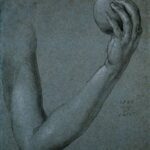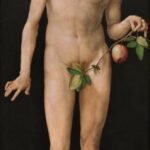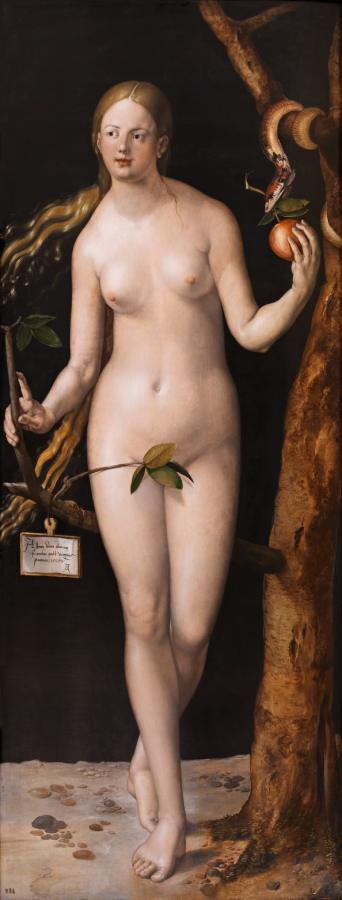Dürer, Albrecht (1471-1528)
Eve
1507
Oil on panel, 209 x 80 cm
Museo del Prado, Madrid
Like the painting of Adam, represented on a separate panel, Eve’s unstable posture, her rhythmical movements and her affected gestures are sometimes interpreted as a return to earlier models of Gothic art, instead of what they really are, a foretaste of Mannerism. The solidity of the two bodies, Eve’s slightly Gothic curves -the prototype of a Germanic Venus- and Adam‘s fascinated expression, his mouth open in a personification of desire; are outstanding aspects of these two grandiose nudes, the first life-size ones in all of northern painting. Dürer nuances the differences between the two bodies, using a tan color for the man’s and a pinkish white one for the woman. And he conceives them as isolated, rather than alluding to the fall of Adam and Original Sin, which are subtly symbolized in the character’s expressions and in the motives that accompany them. The reference on the tablet to the fact that the work was painted after the Virgin gave birth (Christmas) determines its date of execution more exactly and alludes to Mary as the new Eve, who saves men from the sin which Adam and Eve are about to commit. Dürer set out his studies and conclusions in a treatise on the proportions of the human body and perspective. This was a fundamental text for successive generations of northern artists. Queen Christine of Sweden gave this painting to Felipe IV. (MNP)
Study:
 Dürer, Albrecht (1471-1528)
Dürer, Albrecht (1471-1528)
Arm of Eve
1507
Cleveland Museum of Art, Cleveland
Companion:
 Dürer, Albrecht (1471-1528)
Dürer, Albrecht (1471-1528)
Adam
1507
Museo del Prado, Madrid
